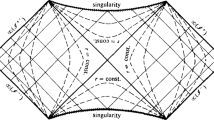Abstract
In general relativity space-like or null singularities are common: they imply that ‘time’ can have a beginning or end. Well-known examples are singularities inside black holes and initial or final singularities in expanding or contracting universes. In recent times, string theory is providing new perspectives of such singularities which may lead to an understanding of these in the standard framework of time evolution in quantum mechanics. In this article, we describe some of these approaches.
Similar content being viewed by others
References
S. R. Das, Mod. Phys. Lett. A20, 2101 (2005)
B. Craps, Big Bang models in string theory, arXiv:hep-th/0605199
M Gasperini and G. Veneziano, Phys. Rep. 373, 1 (2003), arXiv:hep-th/0207130
H Liu, G W Moore and N Seiberg, The challenging cosmic singularity, arXiv:gr-qc/0301001
E Silverstein, Singularities and closed string tachyons, arXiv:hep-th/0602230
Sidney Coleman, 1/N, Proceedings of the 1979 International School of Subnuclear Physics (1979) 0011
Standard textbooks on String theory include [8] and [9]
M Green, J Schwarz and E Witten, Superstring theory (Cambridge University Press, 1987) vols 1 and 2
J Polchinski, String theory (Cambridge University Press, 1998) vols 1 and 2
I R Klebanov, String theory in two-dimensions, arXiv:hep-th/9108019
S R Das, The one-dimensional matrix model and string theory, arXiv:hep-th/9211085
E J Martinec, Matrix models and 2D string theory, arXiv:hep-th/0410136
A Sen, An introduction to non-perturbative string theory, arXiv:hep-th/9802051
C V Johnson, D-brane primer, arXiv:hep-th/0007170
S R Das and S D Mathur, Ann. Rev. Nucl. Part Sci. 50, 153 (2000), arXiv:gr-qc/0105063
J R David, G Mandal and S R Wadia, Phys. Rep. 369, 549 (2002), arXiv:hep-th/0203048
O Aharony, S S Gubser, J M Maldacena, H Ooguri and Y Oz, Phys. Rep. 323, 183 (2000), arXiv:hep-th/9905111
V Balasubramanian, E G Gimon and D Minic, J. High Energy Phys. 0005, 014 (2000), arXiv:hep-th/0003147
R Bousso, Rev. Mod. Phys. 74, 825 (2002), arXiv:hep-th/0203101
W Taylor, Rev. Mod. Phys. 73, 419 (2001), arXiv:hep-th/0101126
H Aoki, S Iso, H Kawai, Y Kitazawa, A Tsuchiya and T Tada, Prog. Theor. Phys. Suppl. 134, 47 (1999), arXiv:hep-th/9908038
F Hacquebord, Symmetries and interactions in matrix string theory, arXiv:hep-th/9909227
B Craps, S Sethi and E P Verlinde, J. High Energy Phys. 0510, 005 (2005), arXiv:hep-th/0506180
S R Das and J Michelson, Phys. Rev. D72, 086005 (2005), arXiv:hep-th/0508068
S R Das and J Michelson, Matrix membrane Big Bangs and D-brane production, arXiv:hep-th/0602099
S R Das, J Michelson, K Narayan and S P Trivedi, arXiv:hep-th/0602107
C S Chu and P M Ho, J. High Energy Phys. 0604, 013 (2006), arXiv:hep-th/0602054
Author information
Authors and Affiliations
Rights and permissions
About this article
Cite this article
Das, S.R. String theory and cosmological singularities. Pramana - J Phys 69, 93–108 (2007). https://doi.org/10.1007/s12043-007-0112-7
Published:
Issue Date:
DOI: https://doi.org/10.1007/s12043-007-0112-7




